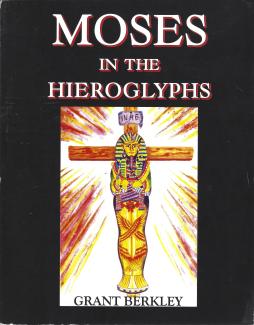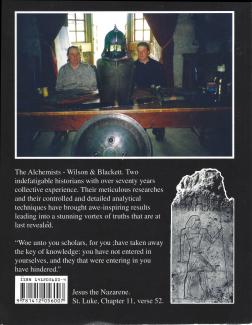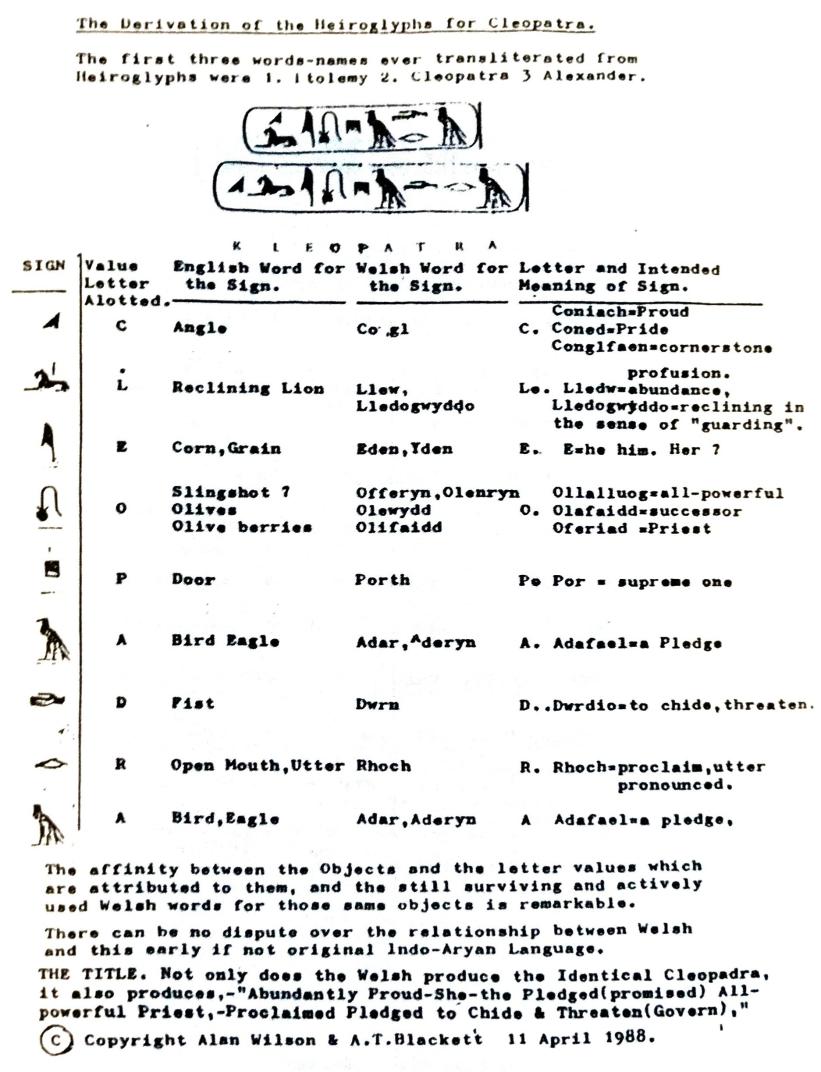The Alchemists - Wilson & Blackett. Two indefatigable historians with over seventy years collective experience. Their meticulous researches and their controlled and detailed analytical techniques have brought awe-inspiring results leading into a stunning vortex of truths that are at last revealed.
“Woe unto you scholars, for you have taken away the key of knowledge: you have not entered in yourselves, and they that were entering in you have hindered.”
Jesus the Nazarene.
St, Luke, Chapter 11, verse 52.
The blurb reproduced above promises "a stunning vortex of truths" - whatever that means - but does nothing to indicate what the book is about, which is the astonishing discovery made by Alan Wilson and Baram Blackett, "the alchemists", that the Egyptians of the pyramids actually spoke Welsh. The ancient language of the British Isles, Khumric, the forerunner of modern Welsh, was the tongue in which Nefertiti cooed to her camel.
With that understanding, the hieroglyphs of the tombs of the pharaohs can be freshly decoded, giving rise to a revised Egyptian history that the author anticipates will irk the archaeological establishment, which he regards as made up of closed-minded dinosaurs. Much of this volume, a bulky paperback which runs to nearly 500 pages, is taken up with attacks on academics, whether individually by name or as a group.
The majority of people who read books on History and archaeology do so for relaxation and pleasure. They unwind from their activities of the working day with an excursion into the imagination that takes them to distant places and times of long ago. This means that the books that are written on these subjects are generally read in an atmosphere of acceptance, and without criticism. In academic circles the late 20th century saw the culmination of the practice where no academic ever criticised the blunderings of any other academic. Outsiders might be attacked on any pretext, but within the cosy, comfortable, closed circles, no disagreement or any form of objection was allowed.
(Anyone who thinks that academics did not disagree with each other in the late twentieth century should look at the case of the Tărtăria tablets, apparently found in Romania in 1961. Practically everything to do with this discovery is the subject of considerable dispute, particularly their supposed age and significance for the history of writing.)
So, how should one read the hieroglyphs? For each symbol, one needs to chose the right Welsh word and its initial letter is then used in spelling out the message. In addition, there is a secondary meaning for each symbol, suggested by another Welsh word that begins with the same letter.
There are some problems with this "method" which are tackled by Caleb Howells in an informative video. Looking at the comments beneath, which suggest that this post may attract a similar level of criticism, I cannot see that any of Howells' critics really address his main point, which is that since there is no direct evidence of a connection between Welsh and ancient Egyptian anyone trying to make the link has to show that Welsh has unique properties in this regard and that you could not pull Wilson and Blackett's trick using any other language. Those who support Wilson and Blackett have to show that only Welsh will provide meaningful results, a much harder thing to do than is evidenced in their work and Berkley's. Simply producing somewhat plausible translations is not enough, given that they are able to select the words they land on from a wide number of possibilities.
But, for a moment, let us take it on trust that Blackett and Wilson could use this method to read hieroglyphics and thereby provide a completely new interpretation of them. What "stunning vortex of truths" is unveiled, previously unknown to scholarship? Why, nothing less than the "revised chronology" of Immanuel Velikovsky, the man who reverse-engineered history so it agreed with the Bible, using the Solar System like a pinball machine with planets flying past the Earth whenever some grand catastrophe was recorded in scripture.
One thing Berkley has failed to learn from Velikovsky is the virtue of remembering that the reader might have limits to their tolerance for indigestible material. Velikovsky, for all his faults, was able to make his nonsense appealing. Berkley expects the reader to wade through page after page of tabular "deciphering" of hieroglyphs like the one shown above, interspersed with breathless rewritings of ancient history based on what they supposedly tell us.
In perhaps the most significant example, the tomb of Ra-Hotep is examined closely and proved to be that of someone better known under a different name:
The inscription running along the top section of the stone panel reads as :-
“(This) means of support (for) the Wayfarer with the broken voice who sends a message, to you a glassful (your cup is filled) is given, this is recorded (enacted) to you.”
Obviously, the "Wayfarer" is Moses, the only man in ancient Egypt who might have been so described. The reference to his "broken voice" is the clincher.
Moses suffered from a speech impediment as a result of burning his mouth with fire as a child in the Pharaoh’s superstitious trial, and this was why Moses needed his brother Aaron to speak for him.
The third section of hieroglyphs is damaged, and it cannot be read to get a true reading in its entirety. It does however commence with the statement meaning that “a message was sent” which requested shelter. The middle section is damaged, but the ending of this text again states that “to the sanctified person things are bestowed”, and that all this is recorded to him in a deed. So the identification of a “sanctified person” can now be added to that of Wayfarer, the Wanderer, the one of Hoarse Voice. the Law-Giver, and he who understood things, and who was named Mwseff = Moses.
The effect of this translation on the normally phlegmatic, and never excitable, Alan Wilson, and the implacably logical Baram Blackett, was electrifying. However, there was no doubt that here they were confronted with the legendary Moses in person. The histories were consistently being revealed as accurate, and only confused by the misdating and mistranslations, and Moses was soon just another milestone on the journey. There was no rejoicing or jubilation as the ever-present problem, which was lurking like a giant stinking shadow, was the difficulty of ever doing anything useful or constructive with all this whilst the usual academic ‘deja vous’ prevailed with the stale paradigms, and the ever-present obsequious conformity with peers.
Those rotten academics again, with their unwillingness to take harebrained speculations seriously.
At the time it became all the more important to read the inscriptions painted on the statues of “Ra-Hotep” Moses, and his wife, presumably Zipporah the daughter of Reu’el, - Jethro. These painted hieroglyphic texts were much neater and much longer than the stone carved hieroglyphs on the panel. and the transliterations were done slowly and methodically in the same painstaking manner, - setting out the signs - stating the English word for each sign - looking up the words for that sign in the three Welsh dictionaries employed. This is what was found to be written on the throne of “Ra-Hotep” the upper left hand side close to his head: -
“In your evening to you plenty is intended you maimed genius.”
“In your migration the army surrounded was given to you through holiness made to bow down pulverised.”
“To you philosopher a message (was given) to move forward (on a journey) to explore a way was given.”
These inscriptions provide further evidence that Ra-Hotep was Moses. After all, no less than three Welsh dictionaries were consulted. Still, Berkley is pessimistic about getting a hearing from the gatekeepers of Academe:
[Even though] the discovery that has been made is verifiable. accurate. and useful. [...] the reader must beware of the automatic, destructive, self-preservation, knee-jerk of academics who will be desperate to protect their reputations, and their desired monopoly of the subject, and this can never be over-stated nor too often stated. Alan Wilson once saw a dog struck by a motor vehicle, and when a man went to try to help the frightened and injured animal it bit him. This discovery may be the “holy greal” which academics have longed for, but have despaired of ever finding. but it is unlikely that they will want to drink from this fountain.
In this giddy hayride of metaphors, the thesis of Blackett and Wilson is at once an injurious motor-car, a kindly stranger, a sacred object and a fountain. Faced with all that, small wonder that the establishment has not jumped up and licked his face in appreciation.



Leave a comment